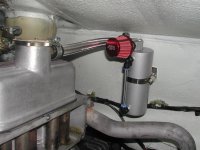Hi Thomas,
Looking at the various engines in your youtube video, I can see what appears to be a breather pipe attached just below the oil filler cap and going to somewhere at the rear of the engine (see images at 13, 26, 29, 32, 39 secs etc).
I suspect the additional pipe from the fuel pump mounting to a modified valve cover is to allow crankcase pressure to travel more freely to the valve cover and then out through the breather pipe just under the oil filler cap.
If you think about it, how does the crankcase pressure get from the crankcase to the valve cover and out the breather normally? Up the pushrod tubes? which are also draining the excess oil from the valve gear? Perhaps it's an attempt to prevent the crankcase gases from also picking up oil droplets and carrying them out the breather pipe.
Other reasons might be to prevent oil loss, leading to a low oil level with possible engine damage (starved bearings) particularly under conditions of oil surge (heavy braking, hard cornering, oops! I nearly said hard acceleration there....

). It's not unusual on race/modified engines to run slightly more clearance between pistons and cylinders (especially on air-cooled engines), higher compression ratios and higher revs, these 3 factors can result in more oil being consumed or lost due to blow-by.
I reckon that the hard-to-see breather pipe in the video is actually directed into an oil catch tank and doesn't vent onto the road. (unlikely to allowed in motorsport!).
So any of you guys with a breather pipe venting onto the road, please copy the racing guys and fit a catch tank. It doesn't have to anything elaborate, just a sturdy plastic bottle will do fine. Please don't be dropping oil on roads,
some of us ride motorcycles ! (How's the BMW by the way?).
In case you think that an occasional drop of oil falling on the road is of no consequence, think again. There's 568cc (or ml) in a pint. There's 5280 ft in a mile. If you drop 1 drop every 10 feet, that 528cc in a mile, almost 1 pint!
At that rate, a Fiat 500 could be out of oil in a few miles.

(I think my maths are correct, if not, I'm citing old age, deteriorating eyesight and being way past my bedtime!

).
Re:- the practice of recirculating the crankcase gases (on an older, worn engine = oil fumes/mist!), apart from preventing the venting of oily fumes into the atmosphere, it was found that creating negative pressure in the crankcase (by essentially 'sucking' out the fumes) helped to avoid engine oil leaks especially past seals.
When faced with a badly worn engine in the past, I often had to vent the breather to the atmosphere and blank-off the connection to the carb. in order to stop the engine choking on it's own fumes. If your worn engine peters out when left idling for a while - try disconnecting the breather pipe connection at the carb to see if this is what might be happening. Some Fiat carbs have a type of fibre? disc valve on the throttle spindle which is supposed to stop the engine drawing in fumes at idle - I've seen these with bits broken-off or incorrectly fitted to the throttle shaft....when re-assembling a carb, try to put things back as they're meant to be - helps if you understand what all the parts do...
Rambling over.....
(for tonight

)
Al.




